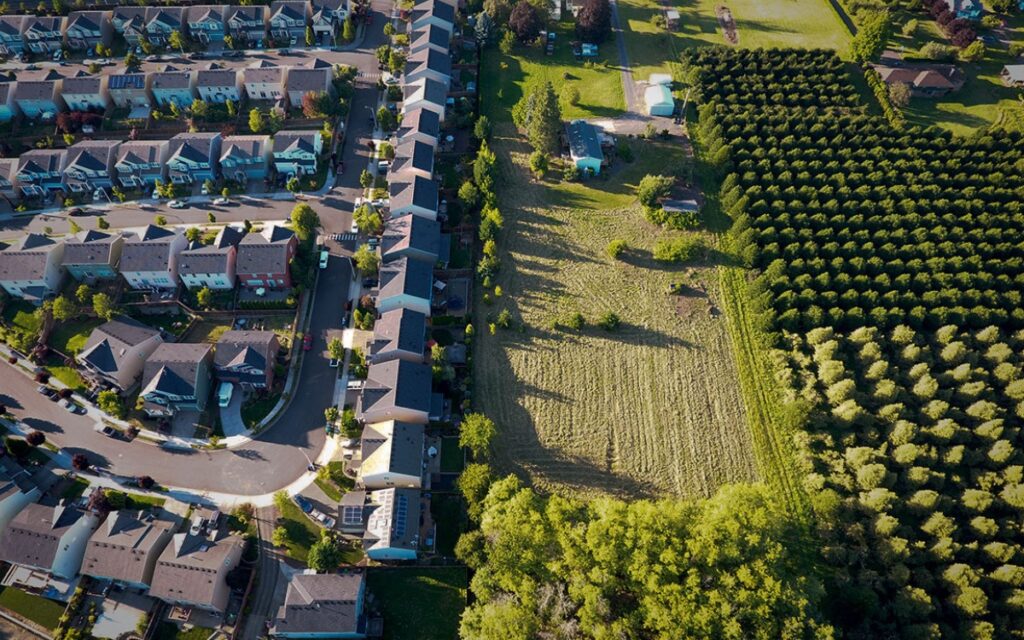
The move, which reverses a recent decision by Hamilton City Council to restrict all development to the city’s current urban area, has drawn both support and criticism from local officials and stakeholders. Photo credit: Modern Farmer
On Friday, November 4, the Ontario government announced it will be expanding Hamilton’s urban boundary to allow for more residential construction in a move that is meant to combat sky-high housing prices.
The urban boundary expansion will include opening up 2,200 hectares of undeveloped land to new development. The province also rejected a proposed 30-storey height limit on buildings.
The West End Home Builders’ Association (WEHBA) came out in full support of the provincial government’s decision.
“These adjustments are necessary and in the public interest, given the significant housing shortage our City and economic region is facing. Without addressing this, Hamilton will continue to see major displacement of our residents to neighbouring communities,” the organisation wrote in a press release.
Hamilton is expected to grow by 236,000 people over the next 30 years, reaching a total population of 820,000 by 2051. To accommodate projected growth, the city will need to add more than 110,000 housing units.
Oxford Economics North America Housing Affordability Indices (HAIs) has consistently ranked Hamilton as the third least affordable housing market in all of North America, with only Vancouver and Toronto ranking higher.
Despite the apparent necessity of expanding the urban boundary, the move puts the provincial government at odds with an earlier decision made by Hamilton City Council to restrict development to the city’s current urban area.
Some newly elected city councillors have already announced their intentions to resist the move, even though they are unable to overrule the province.
Ward 8 (Garth-Upper Wellington) Councillor-Elect John-Paul Danko declared “we can and will resist” the urban boundary expansion.
He went on to suggest one form of possible resistance, writing that, “growth cannot proceed without servicing” and he sees “no reason” why Council would approve funding servicing the land.
Hamilton Councillor-Elects Craig Cassar, Cameron Kroetsch, Nrinder Nann, Alex Wilson, and Maureen Wilson have also been vocal on social media about their opposition to the decision, with some of them also attending “Stop the Sprawl” rallies in response.
Likewise, Mayor-Elect Andrea Horwath called the decision “very concerning.”
Any expansion cannot proceed until secondary planning work is complete. Hamilton city staff are reviewing the details and will report to Council on November 29, 2022. The new Hamilton City Council is sworn in on Tuesday, November 15, 2022.
Lynda Lukasik, the head of the environmental activist group Environment Hamilton, told the Hamilton Spectator that the city “will see people mobilising to oppose this…civil disobedience, whatever it takes.”
“Stop the Sprawl” supporters have pointed to the results of a City of Hamilton mailout survey as proof that public opinion is overwhelmingly on their side. The city survey found that 90.4 per cent of respondents were opposed to urban boundary expansion.
However, a report prepared for Toronto Metropolitan University’s (formerly Ryerson University) Urban Research and Land Development Centre by Senior Research Fellow Frank Clayton draws the conclusion that “the overwhelming support the City Survey results show for the No Urban Boundary Expansion option is deceptive and not representative of the population.”
The report continues that “the survey was too limited in the options listed, did not represent random sampling, and there is little doubt that it was hijacked by opponents of urban expansion.”
A scientific RDD dual frame (land and cell line) random telephone survey on the urban boundary expansion question was conducted by Canadian polling company Nanos Research from August 24 to September 18, 2021.
It found the issue to be much more contentious, with 38 per cent of respondents saying that they support an expansion to the urban boundary, 32 per cent in support of keeping the boundary the same, 22 per cent in favour of slowing down new growth in Hamilton altogether, and 8 per cent unsure.
It should be noted that the poll was commissioned by the Ontario Real Estate Association (OREA), West End Home Builders’ Association (WEHBA), and the REALTORS® Association of Hamilton-Burlington (RAHB). Results are considered accurate plus or minus 3.7 percentage points 19 times out of 20 and are specific to the time frame of the sampling (August 24 to September 18, 2021).
Based in Hamilton, Ontario, Kevin Geenen reaches hundreds of thousands of people monthly on social media. He is a regular contributor with The Hamilton Independent and has been published in The Hamilton Spectator, Stoney Creek News, and Bay Observer. He has also been a segment host with Cable 14 Hamilton. He is known for Hamilton Neighbourhood Watch crime updates and no-nonsense news graphics. In 2017, he received the Chancellor Full Tuition Scholarship from the University of Ottawa and later graduated with a Bachelor of Arts. He also received the Governor General’s Academic Medal from Governor General David Johnston and formerly worked in a non-partisan role on Parliament Hill in Ottawa. He is also currently employed as an Office Administrator at RE/MAX Escarpment. His journalistic work is independent of his other positions.

Based in Hamilton, he reaches hundreds of thousands of people monthly on Facebook, Instagram, TikTok, and Twitter. He has been published in The Hamilton Spectator, Stoney Creek News, and Bay Observer. He has also been a segment host with Cable 14 Hamilton. In 2017, he received the Chancellor Full Tuition Scholarship from the University of Ottawa (BA, 2022). He has also received the Governor General’s Academic Medal. He formerly worked in a non-partisan role on Parliament Hill in Ottawa.






